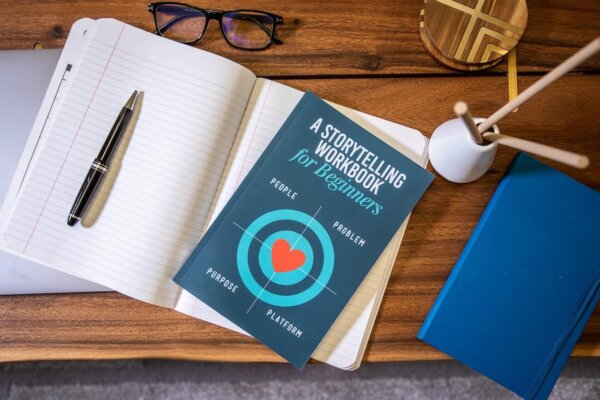
How To Tell Your Brand Story Without Hindering Conversions
Customers are increasingly concerned with who they are buying from. Here’s how to tell your brand story and your products without undermining your sales performance.
To set the scene on how to tell your brand story, I want to share two observations from a study by the Baymard Institute that caught my attention.
- For direct-to-consumer or small product catalog sites, about 62% of users engaged with non-commercial content on pages like About Us, Our Story, Our Mission, etc.
- When testing larger retail sites, Baymard found that only 37% of users explored similar pages.
I was surprised because one of my most common pieces of advice for clients and ecommerce managers is to remove non-commercial links from your primary navigation and tell your story through other strategies.
So, who is right in this scenario and how can you know how to tell your brand story as an ecommerce leader?
I think we can all agree that consumers are being more discerning about where they spend their money, especially in the “35 and under” crowd.
And, I assume that most of you reading this aren’t working at a globally recognized retailer that is already a household name.
It makes sense that online shoppers would be interested in learning more about things like:
- The company’s origin story
- The founder and team behind the brand
- The products and their manufacturing process
- Any environmental or social causes they support
We’ve even seen session recordings of shoppers adding products to their cart and then going back to an about page to learn about the organization they are supporting before completing their purchase.
In my mind, there isn’t much debate about whether or not this information should be published on your site, but I do have strong opinions about where and how it should be presented.
So, in this article, I’ll cover a few recommendations I have for ecommerce leaders wondering how to tell your brand story without hindering conversions.
Tip #1: Some brands and products need more storytelling than others
I get it, your business is your baby. But at the end of the day, there are some product categories where consumers are particularly interested in the details (Ex: apparel, cosmetics, consumable goods) and others where the decision-making process is more transactional.
If someone is shopping for a night light for their kid, are they going to take the time to read the founder’s backstory and research how the product is sourced? Maybe. But it’s more likely that they just want to get an affordable light that works, so they can help their kid feel safer and catch up on some sleep.
Conversely, people who are shopping for products that they wear, apply to their skin, or ingest are going to be much more interested in how those products are sourced, manufactured, packaged, and used. They have a direct impact on that person’s daily experience, so it’s understandable that they are examined a little more closely.
You know your product and your audience better than anyone, so you’re the best person to determine how prominently content like your backstory and production processes needs to be featured. Should it be published somewhere? Probably. Does it need a dedicated page featured in the primary navigation? Maybe not.
Enjoying this article?
Subscribe to our newsletter, Good Question, to get insights like this sent straight to your inbox every week.
Tip #2: Keep your content pages, but move them to the footer
“About Us” style content can absolutely be a differentiating factor for your business. Consumers are increasingly likely to choose a smaller brand over a “soulless conglomerate” when they are presented with the right information.
What is that information, exactly? Here’s what our decade+ of research tells us consumers want to know about you:
- Who do you serve? What problem(s) do you solve?
- What makes your products/company different?
- Who is behind the company? (Founder & Team)
- How did your company get started?
- What do you stand for? What mission/causes do you support?
Shoppers want answers to these questions, and you probably enjoy telling your brand story, so you should absolutely consider putting together a dedicated page to address them.
However, I would still argue that in most cases the dedicated pages that cover your backstory, your mission, and your values should not exist in your primary navigation. That prime real estate is best used for commercial links – product categories, seasonals, new arrivals, accessories, and so on.
In fact, much of our user testing shows that website visitors are actually checking the footer for a column dedicated to “Company Links” when looking for this kind of information.
Am I saying that you shouldn’t tell your brand story? Absolutely not.
Am I telling you to eliminate your about page and shove products in your customers’ faces? No way.
What I’m suggesting is that you keep all of this material, but instead of having it occupy valuable space in your navigation, sprinkle it throughout your website in the form of images, copy, and calls-to-action, and give the dedicated pages a home in the footer, where users are likely to hunt for them if they want that kind of information.
Tip #3: Tell your brand story throughout your site, not just on the about page
At this point, we’ve established that details about your company, your brand, and your products can make the difference between a purchase and an abandoned cart. We’ve also argued that the dedicated pages that communicate those details don’t belong in your primary navigation.
So, assuming those things are both true, how are you supposed to communicate the story behind your brand and products without compromising your conversion rate?
The most successful brands I’ve encountered address this by taking all of that great material from their About Us or Our Process pages and sprinkling it throughout their site. They weave it into their headlines, body copy, product descriptions, and calls to action, so that the brand story feels like part of the customer experience from start to finish.
Here are a handful of places where I think this can be extremely powerful:
Homepage: Hero Section
You only get one chance at a first impression, which is why it’s so frustrating to see so many brands treat this area like an afterthought. Within the first five seconds of visiting, users should be able to answer these three questions:
- What customer segment do you serve?
- What problems do you solve?
- What products do you offer to solve that?
This one site element can do much of the heavy lifting when it comes to telling your brand story. Check out this simple example from athletic outfitter, Camelbak. It covers the product and the brand values in a simple, straightforward hero section.
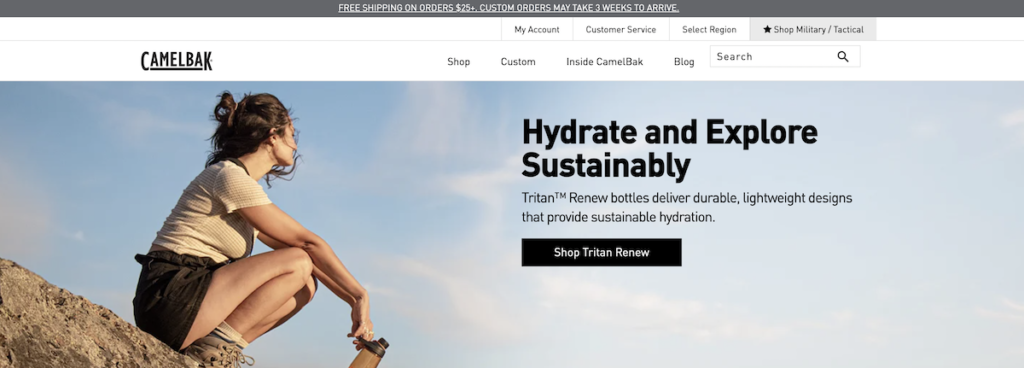
Homepage: About Us Lock-up
Removing your About Us content from your navigation doesn’t mean you have to remove it from your homepage. In fact, I love to see a headline with a 2-3 sentence descriptor somewhere mid-stream. And it can be even more effective if you embed a 2-minute video with the founder story and product details included in the script.
When executed well, this strategy gives users just enough information to separate you from big box retailers without distracting them from their purchasing experience. And, you can always include a text or button link that compels them to “Learn More About Our Company” if you’d like.
Clean beauty brand, Merit, does a great job with this below the fold on their homepage. After focusing on products and key brand value propositions above the fold, they share a short mid-stream panel with a link to About Us. Their emphasis on ‘less is more’ is simple and clear, and there is even an additional short clarifier with ‘Responsible luxury that’s safe for body, skin, and planet.’
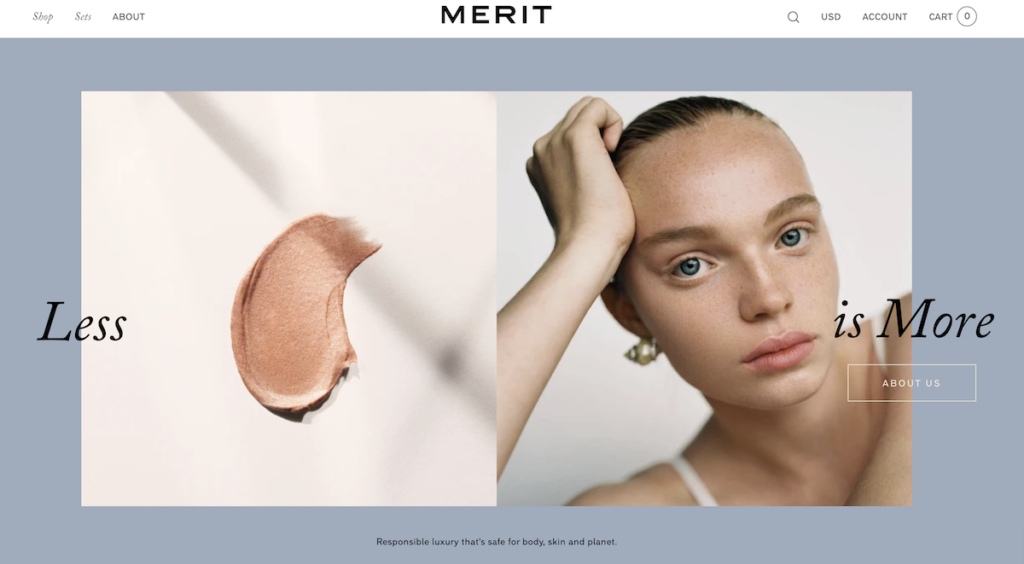
Homepage: Product Lock-ups
It’s pretty common to see a section of the homepage dedicated to “Best Sellers” or “Featured Products,” but those lock-ups almost always miss the mark when it comes to storytelling. Quite often I see a product section that just includes an image, the product name, the number of reviews, and the price.
This is a great opportunity to include a single, punchy line describing what the product is and how it benefits the customers. A phrase as simple as, “This ethically-sourced dark roast is perfect for early mornings at the ski lodge,” can be just enough priming to help the user understand your company and how the product fits into their life a little better.
And please, I’m begging you, include a dedicated call to action – like a button or a “Learn More” link – for each product in the lock-up. So many sites rely on users clicking the image or the product title to explore the product, and we find that it often results in frustration or products being overlooked due to lack of clarity. Even worse: “Add to Cart” – very, very few are ready for that step at this point.
Here is a well-done example from Allbirds, a sustainable clothing brand. On the homepage, they feature a few different products, each with key consumer-focused benefits. And if you hover over the product a call to action appears!
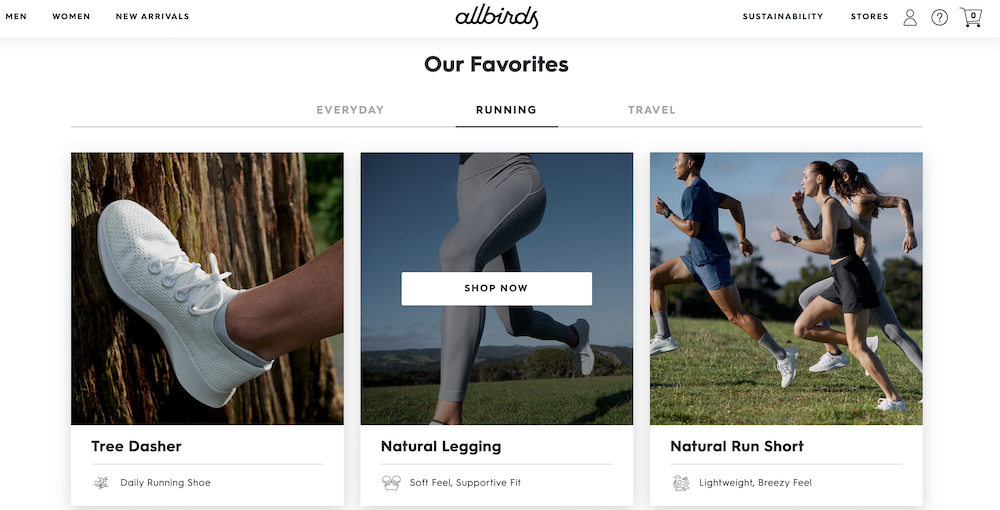
Product Page: Product Details
One of the best places to tell the story of your company and your product is on the product detail page in areas like the product description, product specifications, materials, sizing, or ingredients.
I look at dozens of stores each week, and the vast majority of them have cold, flavorless product copy. It might describe what the product is and what purpose it serves, but it is presented in the same way that a bottle of sunscreen tells you when and how to apply it. Very matter-of-factly.
This is your opportunity to bring personality to your company and your products. Here are a few common product detail areas that could probably use a little pizzazz:
- Product Description – This isn’t an image caption. Tell a story!
- Process Overview – Share what makes your production process different/better.
- Specifications & Requirements – Answer “so what?” Why should I care that you use premium steel or a certain type of fabric for this piece?
- Ingredients – Don’t just tell me what’s in the product. Tell me how it improves my experience.
- Usage Directions – Help me understand how to get the most out of this product, and reassure me that you’re there to help if I need it.
Here is a product page with product details that make it shine from Olive & June, an at-home manicure brand. They provide a few key benefits, a bit of information on why it works, and if you keep scrolling on the page there is great information on how to use it.
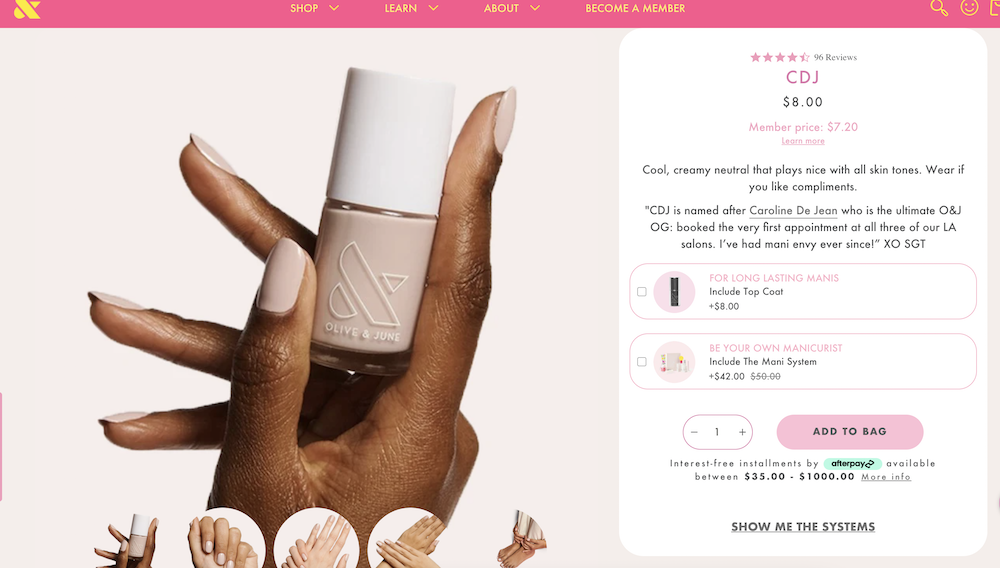
Product Page: Video
When it comes to communication, the most effective method is usually face-to-face. The next best option is video. (Hello, Zoom fatigue!)
I know how hard it can be to produce video content, but if a picture is worth 1,000 words, then a video is worth 10,000. And you’d be surprised how low the bar is for consumer preferences. Simply propping up your smartphone and recording a two minute video is enough to make a difference, I promise.
There are two video formats that I’ve seen work really well here – the “Product Origin Story” and the “How-To Video.”
In the first option, you’re telling the visitor why the product was created, what problem it solves, how it is sourced and produced, and why they should consider purchasing.
In the second option, you’re showing them exactly how to use the product to get the most out of their purchase and describing what benefits they should expect to see after using the product.
You can also include user-generated content if you have it. Whether it’s coming from an influencer or a customer, reviews and testimonials from people outside of the company often outperform an in-house production.
On the Crossnet website, there are many areas where they feature product videos. This is a huge help for visitors who may not know about the new sport, or who are curious how to play.
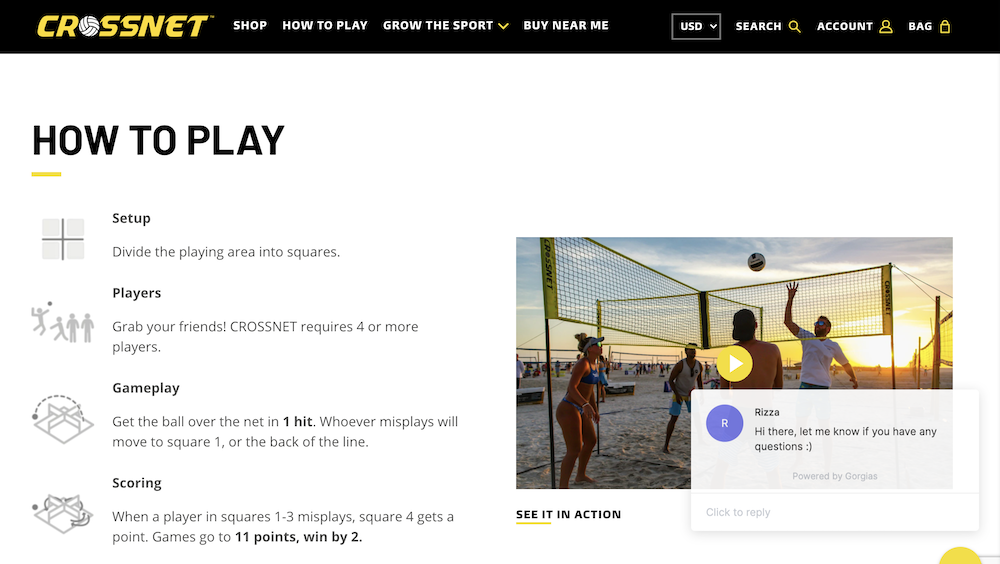
Do you know how to tell your brand story?
Remember, these suggestions are all based on conveying your story PRE-purchase as an effort to convert visitors into customers, but there are also plenty of opportunities to tell your brand story post-purchase, through channels like email, unboxing experience, SMS, customer support, etc.
But, in the interest of time, we’ll save the post-purchase touchpoints for another day.
Since you made it this far, I’m curious about a few things:
- Where is your “About Us” content currently presented?
- How much traffic do your company pages get? Are they in the top 5 for the entire site?
- Where do you come down on the About links in a navigation versus footer debate?
- What questions do you have that we can address next time?
If you have the time, I’d love to hear your thoughts. Connect with me on Twitter and let me know!

About the Author
James Sowers
James Sowers is the former Director of The Good Ventures. He has more than a decade of experience helping software and ecommerce companies accelerate their growth and improve their customer experience.